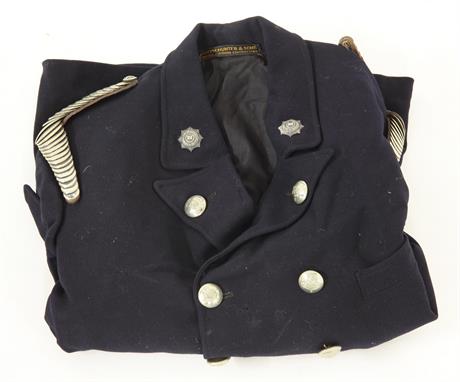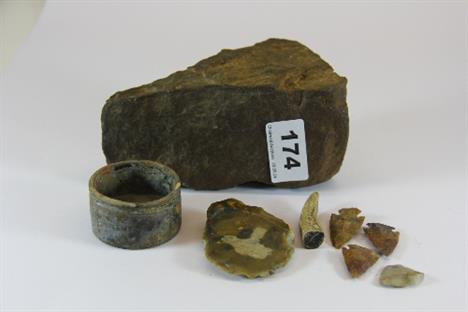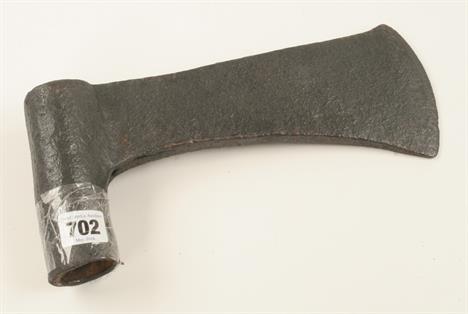We found 14740 price guide item(s) matching your search
There are 14740 lots that match your search criteria. Subscribe now to get instant access to the full price guide service.
Click here to subscribe- List
- Grid
-
14740 item(s)/page
A 19th/20th Century Axe, Democratic Republic of Conga, Luba, Songye. The curved iron blade having a pierced centre infilled with intricately worked wrought iron bars; interlaced and adorned with protuberant face masks, and set on a club form shaft clad in sheet copper with a flat ended flared terminal, 14 ins (36 cms) in length. [An almost identical example can be seen at the Metropolitan Museum of Art: The Michael C Rockefeller Memorial Collection, gifted from Dr & Mrs Werner Muensterberger, 1959].
A Dresden porcelain figure, 20th Century, of a boy seated on a sledge holding an axe, printed and impressed factory marks to base, height approx 14cm, together with a pair of Capodimonte figures of a girl grape picker and a boy with a wheat sheaf, a Capodimonte figure group of a lady and gallant and a collection of other Continental figures (some faults).
IMPORTANT SERVICE DE TABLE DE 153 PIECES EN CRISTAL TAILLE ET PORCELAINE A DECOR BLEU ET OR, DE LA MANUFACTURE DE JOHN F.H. VOGT, AUX ARMES DES PRINCES ARGUTINSKY DOLGORUKY. Il comprend : - 4 carafes à vin - carafe à eau - 1 pichet à orangeade - 11 coupes à champagne - 9 verres à vin - 13 verres à eau - 12 verres en cristal coloré vert - 14 verres à pied à liqueur - 12 petits verres à liqueur - 11 petits verres à anses à vodka. -12 assiettes à soupe -10 assiettes plates -11 petites assiettes - 10 tasses et 12 sous-tasses - 3 grands plats de service - 2 navettes - 3 saucières dont une avec un couvercle - 1 importante soupière couverte avec son plateau de présentation. (Petites égrenures.) Historique : ARGUTINSKY DOLGORUKY Famille princière originaire d¹Arménie, que la tradition fait descendre du Roi de Perse Artaxerxès dit « Longue main ». Iossip ARGOUTINSNSKY (1758-1800) qui rendit de grands services à la Russie, reçut de Paul Ier le titre de Prince russe par oukaze du 22 mars 1800 sous le nom d’ARGOUTINSKY-DOLGOROUKOV. Cette famille n¹a bien entendu aucune parenté avec la famille rurikide des Princes Dolgoroukov. Quelques membres célèbres de la famille : -Prince Vladimir NICOLAEVITCH, en 1913 gentilhomme de la Chambre, diplomate et collectionneur. -Prince Constantin SERGUEEVITCH, né en 1876, capitaine au régiment Préobajensky de la Garde. -Prince Nicolaï VASSILIEVITCH, en 1913 conseiller d¹état, chambellan de la Cour. Le service provient probablement d¹un de ces personnages de la Cour impériale russe. COLLECTION D’ARMES DE L’AZANOUR ALEXIS PARMENISDZE, SEIGNEUR DE GEORGIE Les armes anciennes de Géorgie Le grand poète russe Lermontov se référait souvent dans ses poèmes aux armes caucasiennes, surtout géorgiennes, en soulignant toujours leurs qualités guerrières, l’excellence de leurs exécutions et de leurs décorations. Beaucoup de celles qui nous restent confirment amplement cette haute appréciation. Les armes furent toujours un domaine traditionnel de l’artisanat de la Géorgie. De tout temps, s’étalant sur plusieurs siècles de sa tragique Histoire, les artisans géorgiens fabriquaient des armes de toutes sortes employant pour cette tache leur grande expérience. Dans leur arsenal, au-delà des variantes que l’on ne rencontre pratiquement pas au dehors des frontières de la Georgiecomme les boucliers où les sabres aux poignées nettement rabattues avec de légères ferrures, on trouve des poignards droits à double tranchants, des pistolets, des sabres caractéristiques du Moyen-Orient ainsi que des armures qui se sont imposés dans tout le Caucase et la Transcaucasie. En dehors de leurs fonctions premières, les armes de Georgie étaient de tout temps, considérées comme l’attribut d’un rituel guerrier, mais aussi comme un élément de décoration faisant obligatoirement partie du costume national traditionnel. C’est pourquoi on accordait à la décoration de l’arme pas moins d’importance qu’à ses fonctions premières. En prenant en compte l’héritage de la précieuse culture ancestrale de leur patrie, les armuriers de la Georgie ont atteint dans leurs décorations les sommets d’un art authentique. Ils maîtrisaient parfaitement tous les procédés de décorations utilisés en Orient, donnant un effet maximal à tel ou tel objet . Utilisant le célèbre acier de Damas pour les lames de sabres ou des poignards, ces lames étaient accompagnées d’incrustations ou d’incisions dorées sur la surface du métal. Employant l’argent ciselé, doré et la technique niellé pour l’enchâssure de l’arme, les artisans combinaient avec art l’argent le bois, les différentes cornes et les pierres semi-précieuses. Le centre en pointe dans l’élaboration de ces armes de haute qualité était la capitale éternelle de la Georgie et de toute la Transcaucasie, Tiflis, l’actuelle Tbilissi, capitale de la Georgie contemporaine. On peut juger de la valeur des armuriers de Tiflis, d’un long passé, grâce aux différentes réalisations signées seulement du nom de leurs artisans. Plus tard, environ à partir de la fin du XVIIIè siècle, apparaissent souvent, à coté de la signature de l’artisan, la date et le lieu de leur réalisation. Une des plus belles collections d’armes de Géorgie, constituant une des plus belles parts mondiales de la collection d’armes artistiques se trouve actuellement au musée d’Etat de l’Ermitage. Les armes à feu Un proverbe kurde dit : «le poignard est un frère, le fusil n’est qu’un cousin». Excellents cavaliers, les caucasiens et géorgiens étaient surtout des sabreurs ayant des réticences envers l’arme à feu. C’est un système à la miquelet dans une variante locale dite à la«morlaque»qui équipa presque tous les types traditionnels d’armes à feu courtes et longues jusqu’au XIXe siecle. Ce type de platine se caractérise avec un grand ressort extérieur agissant directement sur le pied du chien, batterie intégrée au couvre bassinet, double gâchette interne fonctionnant dans un plan horizontal, la morlaque caucasienne se distingue extérieurement par la présence d’un« tablier», plaque métallique joignant l’axe du chien à celui du couvre bassinet. En dépit de l’image de sabreurs, tous les caucasiens demeurent des virtuoses du tir au fusil et au pistolet, ils étaient entraînés dès le plus jeune âge, et considérés comme tireurs d’élite. Les armes blanches Le khmali Il est une arme qui se distingue radicalement de tous les autres types de sabres traditionnels au point d’avoir imposé pour la designér son nom caucasien «shashka» ou géorgien «khmali». Le pommeau forme un bec prononcé, évoquant une tête de rapace, de plus il est généralement fendu en V formant ainsi deux oreilles. Les plus luxueux ont une monture en argent ciselé ou niellé. Le fourreau est en bois gainé, avec chape, bouterolle et renforts intermédiaires en métal, le bas de la monture peut coiffer l’ouverture du fourreau ou au contraire s’y enfoncer profondément, ne laissant dépasser que le pommeau. Les anneaux de bélière sont ainsi disposés afin que l’arme soit toujours portée avec la courbe du tranchant vers l’arrière, à l’inverse de tous les sabres occidentaux et des cimeterres, le khmali est ainsi dégainé, d’un geste particulier, la tranche de la main droite retournée venant se bloquer contre le bec du pommeau, tirant l’arme vers le haut et l’avant. Le khmali est surtout une arme de cavalier. Le khanjali Le khanjali est essentiellement destiné aux coups d’estoc, les coups de taille étant portés au khmali. Il est connu également sous son nom caucasien de «Kindjal». C’est l’arme blanche la plus typique de tous les Caucasiens et Georgiens qui fait obligatoirement parti de leur costume national le «TSHOKHA». Sur le plan symbolique, il illustre dans tout le Caucase le statut d’homme libre Les techniques du décor La plus connue est celle du NIELLE, que l’on le rencontre essentiellement sur les armes caucasiennes. Le nielle est une sorte d’email sombre,aux reflets bleu noir inimitable. Il est fait de cuivre, plomb, soufre et borax, coulé dans des motifs creusés sur le métal support,puis soigneusement poli. Habituellement il est réalisé sur de l’argent, sur du vermeil, de l’or. En général le nielle est employé avec discrétion et une précision parfaite sur des armes anciennes de bonne facture. Le damasquinage Il s’agit d’une incrustation de métal précieux dans le métal de l’arme. Les lames d’armes blanches et les canons d’armes à feu sont généralement damasquinés à l’or. Le damasquinage à l’argent est réservé aux parties secondaires comme les montures métalliques de poignards ou les gardes de sabre. Les motifs décoratifs sont souvent à prédominance végétale (rinceaux) et géométrique.
BRITAINS Swoppets a dealers late 7475 Knights counter pack display Box containing 36 x figures - six of each of 1470 - with Lance, 1471 - with Sword, 1472 - Longgbowman, 1473 - with Pike or long Axe, 1474 - with Axe and 1475 - Crossbowman. All the figures are Near Mint and complete with all held and belted weapons. The Box is in Excellent plus condition with 6 x original individual oblong card containers for each type of figure.
BRITAINS Swoppets a dealers late 7475 Knights counter pack display Box containing 36 x figures - six of each of 1470 - with Lance, 1471 - with Sword, 1472 - Longgbowman, 1473 - with Pike or long Axe, 1474 - with Axe and 1475 - Crossbowman. All the figures are Near Mint and complete with all held and belted weapons. The outer Box is in Excellent condition but missing the 6 x original individual oblong card containers for each type of figure. The figures are contained within a temporary divider.
A 19th Century Indian cast bronze figure of Ganesh, raised on an hexagonal base, 17 cm high CONDITION REPORTS Overall with some general wear, scuffs and dirt, axe to left hand is bent and mis-shapen and appears to be broken off, implement to other hand also appears to be bent and mis-shapen and may have area missing, generally some irregularities and pitting to the casting, base quite irregular in shape and appears to have had a join and/or repaired split down the side, trunk quite pitted and with tarnish and possible split/repair.
A Mdina glass vase, 25 cm high, and other Mdina glass (16) Condition report Report by NG No pieces signed anything other than Mdina. Fish/axe head vase, approx. 25 cm high: light surface scratches and light scratches to base. Turquoise/yellow/green triangular vase, approx. 25 cm high: wear to base, top probably ground down, light scratches. Brown/yellow and clear glass goblet, approx. 15 cm high: light wear. Red/orange/blue/green trail cylinder vase, approx. 16 cm high: base worn, signed Mdina, surface scratches and some wear. Pink rimmed bowl, approx. 19.5 cm diameter: heavy wear to base, some other scratches. Brown/yellow glass bowl, approx. 15 cm diameter: base with light wear, some heavier to edges, signed Mdina, base a bit wobbly, some other scratches to body. Turquoise globular vase, approx. 12.5 cm high: heavyish wear to base, and some light surface scratches. Green/ blue/ yellow and clear glass ashtray, approx. 16 cm wide: large lump/imperfection to side of base. Wear to base, other light scratches. Round blue/green/ white glass paperweight, 11.5 cm high: light wear to base and some light surface scratches. Turquoise/ green and clear glass moon flask type vase, approx. 14.5 cm: heavyish wear to base, some light scratches Amber/white/clear glass vase, approx. 11 cm high: heavy wear and a chip to base. Light purple/yellow/iridescent type glass vase, 13 cm high: very heavy wear to base, other surface scratches. Blue/yellow/green and clear glass vase, approx. 7.5 cm high, approx. 13.5 cm diameter: heavy wear to base, a couple of small nibbles, some surface scratches and blown bubbles to surface around trailed decoration. Red/orange/clear ashtray, approx. 15.5 cm diameter: wear to base, signed Mdina, light surface scratches, also bears Mdina glass label. Clear/blue/green/yellow glass basket, 11 cm high: wear to base, a couple of small nibbles, blown bubble to base, other surface scratches. Blue/green/yellow/clear glass leaf shaped bowl, approx. 9 cm high: light wear to base and blown bubbles to base, light scratches, bears Mdina Glass sticker.
[Lot of 3] Cosmographie ou Tableau des Systemes du Monde [and] Systeme Planetaire Suivant Copernic [and] Theorie des Saisons Expliquees Suivant Copernic par l`Inclinaison de l`Axe Terrestre et Son Parallelisme Constant This fascinating lot of 19th century French engravings and maps reflect then-contemporary astronomical knowledge and theories. A. Cosmographie ou Tableau des Systemes du Monde, by Drioux & Leroy, circa 1872, black & white (16.8 x 11.3""). A sheet that features a collection of diagrams on various planetary systems, global projections, lunar views and Halley`s Comet, seen on October 29th, 1835. Condition: On a moderately toned sheet with minor offsetting and faint scattered foxing. (B+)B. Systeme Planetaire Suivant Copernic, by Anon., circa 1870, hand color (14.1 x 11.0""). Our solar system as shown by Copernicus, with the sun in the middle. Flanked on one side by the Earth-centered planetary systems of both Tycho-Brahe and Ptolemy and on the other with diagrams of the sun in relation to the earth. Condition: A few faint spots, some minute worm holes that are only visible when held up to light, and a small damp stain at the sheet`s top left edge, well away from the engraving. (A)C. Theorie des Saisons Expliquees Suivant Copernic par l`Inclinaison de l`Axe Terrestre et Son Parallelisme Constant, by Anon., circa 1870, black & white (14.7 x 10.9""). This is an uncolored engraving from the same series as the one above, showing the effect of the seasons and the movement of the sun. Condition: There are two minute worm holes around the centerfold that are only visible when held up to light and some minor soiling along the sheet`s edges, far from the image. (A) See description above. 1870-72
Lord Scone`s `Cabinet of Curiosities` An interesting and curious collection that came from Scone Palace, Perthshire (the ancient site of the `Stone of Scone`) and was assembled between 1840 and 1900. This fascinating collection comprises the following objects: a grape shot mounted on a circular marble base labelled` marble from the chimney piece of the Governor`s house in Sevastopol`; a fragment of wood labelled, `a piece of wood dug up near the Malakoff (Crimea)`; a piece of marble from Maupika (Crimea); a pen rest made of two stags horns with three quill pens; a meerschaum pipe in the form of a bird`s head, the case labelled P. Edwards and Co.; a Victorian infants silk glove with a label saying, `glove worn by Margaret Macgregor (afterwards Countess Mansfield) when a baby`; an Australian aboriginal stone hand axe and an Australian aboriginal grinding stone both with labels, `found in a mound at Wangery District of Victoria, 1891, Warambool Public Museum`, together with a letter from Hawksdale dated 30th December 1891 describing where the objects were found; an interesting paper scroll on which is the rare photographic record of Lord Scone`s late nineteenth century expedition to the North Pole with a printed label reading,` I have just returned from the North Pole and I send a bit of it with my photographs`. This collection was auctioned at Christies King Street in May 2007 by permission of the 7th Earl of Mansfield.
-
14740 item(s)/page













































![[Lot of 3] Cosmographie ou Tableau des Systemes du Monde [and] Systeme Planetaire Suivant Copernic [and] Theorie des Saisons](http://lot-images.atgmedia.com/SR/36385/2906594/50-20145813923_468x382.jpg)














